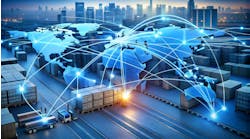Supply Chain 2023: Better Data Brings More Answers
Last year dealt the world's manufacturers and supply chains powerful lessons. Next year they will put those learnings to use, as makers and shippers everywhere invest in new ways to understand and respond to their worlds.
We started last year with expectations of something like a return to normal after the waves of COVID that began in 2020. Instead, we found ourselves dealing with the effects of war in Ukraine, inflation, scarcity of some basic materials, economic slowdowns and continuing COVID lockdowns in key countries. Contrary to many expectations, we're looking at fewer shortages but higher energy prices, geopolitical challenges and consequent rush to remake core systems.
It's not just that we won't go back to normal. It feels like whatever comes next, it will have its own shocks that require more visibility and better control of costs, supplies and timelines. The industry is accelerating moves to better data, more responsive systems, and regionally based manufacturing and supply chain systems.
Data-First Regional Systems
At the heart of this is a data-first regional approach, increasingly leveraging analytics, artificial intelligence and machine learning solutions to provide both a real-time read on performance and predict of future events. Regional manufacturing and supply chain systems will increase as a way to reduce risk and increase control by keeping things closer together.
Often this means increased labor costs, which will be offset with new ways to automate work and increase productivity. One of the most exciting is the use of immersive experiences, like using augmented reality headsets to determine the context of, say, an industrial machine's performance, carbon footprint, maintenance schedule or replacement parts availability. This speeds work, increases uptime and gives greater context not just to the individual machine—but when put into a larger database, the overall performance of a factory, loading port, or railhead. Frontline people can work better and with more intelligence, and planners get a better system view.
Evolutionary Revolutions
In one sense, these big changes are an evolutionary realignment. Enterprise resource planning (ERP) software created efficiencies in the 1990s and 2000s. Offshoring and outsourcing took advantage of cheaper production costs in countries like China. ERP eventually limited system visibility and flexibility, though, since customers couldn't easily change practices or gain insight from new data sources. China's increasing wealth made it a market to sell goods as well as produce them, while labor and land costs rose.
Through more and better inputs, however, an ERP-driven supply chain eventually becomes a data-driven supply chain. Automation, AR and other productivity improvements enable companies to transition to new and more sophisticated kinds of manufacturing and supply chain management.
Almost half of the industrial companies in North America have started this upgrade to some degree. They don't usually destroy their older capital investments, but layer on important modifications. The shocks of 2022 have increased the urgency, even as the choices of what can be added have become better and cheaper. Cloud-based data solutions augment older ERP practices. Flexible analysis systems allow modeling from the viewpoints of manufacturers, supply chains and customers—another way data gives greater context.
Ready for the Next New Thing
There are entirely new considerations that older systems can't accommodate, however. The physical realities of climate change, and the politics around this, were never before something our industry needed to think about. They are now, and will be, as far ahead as anyone can see.
Regionalism may have the effect of reducing the industry's carbon footprint, but not if it comes without better planning – more ships traveling shorter distances just one-third full could be a net increase in emissions, and regulators will notice. Better reporting, better data and better forecasting will need to be part of the system.
Freakish weather and other climate-led disruptions will also call for more flexibility than we've seen in the past. Regional approaches, climate and regulation all play a role in creating new alliances and partnerships, creating additional needs for data sharing and transparency.
These all represent challenges to the industry, but I've worked in this sector long enough to know that it is fundamentally strong, forward-looking and unafraid of a challenge. If anything, I'm optimistic about what lies ahead. The investments we're making now, in both core infrastructure and related technology, will enable insight and innovation for years to come, whatever happens.
Hans Thalbauer is managing director, manufacturing and supply chain industries, Google Cloud.




